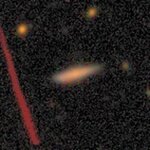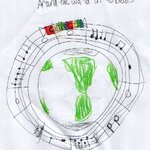Space
Scientists claim that helium rain is the best explanation for the scarcity of neon in the outer layers of Jupiter, the solar system's largest planet. Neon dissolves in the helium raindrops and falls towards the deeper interior where it re-dissolves, depleting the upper layers of both elements, say the authors of the new report in Physical Review Letters.
The research will help refine models of Jupiter's interior and the interiors of other planets. Modeling planetary interiors has become a hot research area since the discovery of hundreds of extrasolar planets living in extreme environments…
The combination of a natural gravitational lens and a sophisticated telescope array has given astronomers the clearest view to date of the "star factories" in SMM J2135-0102, a galaxy over 10 billion light-years from Earth. The distant galaxy, they say, is making new stars 250 times faster than our Galaxy, the Milky Way.
Astronomers also pinpointed four discrete star-forming regions within the galaxy, each over 100 times brighter than locations where stars form in our Galaxy. This is the first time that astronomers have been able to study properties of individual star-forming regions within a…

Anyone can help discover new stuff in Galaxy Zoo- but why do people bother in the first place? In the podcast "Why Go to the Zoo?", Jordan Raddick responds with some unexpected insight into why people donate their time for open science.
Anyone can contribute to science these days-- and you don't even need to know any science! You can run the SETI@home screensaver, to help try to tease out potential alien signals in radio data. You can do protein folding, hunt for comets, search for solar flares, all from the comfort of your home.
Galaxy Zoo is one such crowdsourcing effort.…
The newly discovered gas giant Corot-9b may have an interior that closely resembles those of Jupiter and Saturn in our own Solar System, according to a new paper published today in Nature.
Some evidence also suggest that the exoplanet, discovered last Spring, may also be temperate enough to allow the presence of liquid water.
Corot-9b orbits its star every 95.274 days, a little longer than Mercury takes to go round the Sun. It is the first transiting planet to have both a longer period and a near-circular orbit. Its orbit is slightly elliptical but at closest approach to its parent…

I'm launching a satellite to make music from the ionosphere. But what would that look like, in a dramatic sense? In an evocative sense?
In a perfect world, I could just ask a couple of children to draw me their impression of what 'a satellite making music out of the ionosphere' would look like. Since we live in a perfect world, I did that.
The absolute coolest thing to come out of this was a new Calliope tagphrase: 'Around the world in 48 beats'.
'Around the world in 48 Beats', by Ivy
and
'Project Calliope', by Ivy
and
'Logo', by Max…
New Thermal images of Jupiter's Great Red Spot show swirls of warmer air and cooler regions never seen before, enabling scientists to make the first detailed interior weather map of the giant storm system linking its temperature, winds, pressure and composition with its color.
“This is the first time we can say that there’s an intimate link between environmental conditions — temperature, winds, pressure and composition — and the actual color of the Great Red Spot,” says Leigh Fletcher, lead author of the study in Icarus that documents the research results.
“Although we can speculate, we…

Until recently, it was thought that white dwarfs could not exceed what is known as the Chandrasekhar limit, a critical mass equaling about 1.4 times that of the Sun, before exploding in a supernova.
Since 2003, four supernovae have been discovered that were so bright, cosmologists wondered whether their white dwarfs had surpassed the Chandrasekhar limit, dubbed the "super-Chandrasekhar" supernovae.
Now, a team of astronomers has measured the mass of the white dwarf star that resulted in one of these rare supernovae, called SN 2007if, and confirmed that it has exceeded the Chandrasekhar limit…
The asteroid 1999 RQ36 may be able to tell scientists how the solar system was born, and perhaps, shed light on how life began. The chunk of rock and dust, about 1,900 feet in diameter, also might hit us someday, according to NASA researchers studying the asteroid.
Asteroids are leftovers from the cloud of gas and dust – the solar nebula -- that collapsed to form our sun and the planets about 4.5 billion years ago. As such, they contain the original material from the solar nebula, which can tell us about the conditions of our solar system's birth.
In some asteroids, this material was altered…

An international team of space physicists reports that Mars is constantly losing part of its atmosphere to space as a result of pressure from solar wind pulses. Their new study in Geophysical Research Letters should help scientists better understand the evolution of Mars's atmosphere.
The researchers analyzed solar wind data and satellite observations that track the flux of heavy ions leaving Mars's atmosphere. Results of the analysis showed that Mars's atmosphere does not drift away at a steady pace; instead, atmospheric escape occurs in bursts.
Those bursts of atmospheric loss are likely…

An analysis in Nature of more than 70,000 galaxies by a team of physicists suggests that the universe – at least up to a distance of 3.5 billion light years from Earth – plays by the rules set out 95 years ago by Albert Einstein in his General Theory of Relativity. But that's not all. They also conclude that the existence of ill-defined 'dark matter' is the most likely explanation for the observation that galaxies and galaxy clusters move as if under the influence of some unseen mass, in addition to the stars astronomers observe.
By calculating the clustering of these galaxies, which stretch…